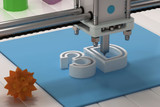How Do 3D Printers works? What's the hype about?
Everyone is talking about 3D printing these days, but what exactly is it? Here’s a quick guide to what all this about, including how a 3d printer works and what it can do.
What is a 3D printer?
3D printers are a new generation of machines that can make everyday things. They’re remarkable because they can produce different kinds of objects, in different materials, all from the same machine.
A 3D printer can make pretty much anything from ceramic cups to plastic toys, metal machine parts, stoneware vases, fancy chocolate cakes or even (one day soon) human body parts.
They replace traditional factory production lines with a single machine, just like home inkjet printers replaced bottles of ink, a printing press, hot metal type and a drying rack.
How do 3D printers work?
You start by designing a 3D object on an ordinary home PC, connect it to a 3D printer, press ‘print’ and then sit back and watch. The process is a bit like making a loaf of sliced bread, but in reverse. Imagine baking each individual slice of bread and then gluing them together into a whole loaf (as opposed to making a whole loaf and then slicing it, like a baker does). That’s basically what a 3D printer does.
The 3D printing process turns a whole object into thousands of tiny little slices, then makes it from the bottom-up, slice by slice. Those tiny layers stick together to form a solid object. Each layer can be very complex, meaning 3D printers can create moving parts like hinges and wheels as part of the same object. You could print a whole bike - handlebars, saddle, frame, wheels, brakes, pedals and chain - ready assembled, without using any tools. It’s just a question of leaving gaps in the right places.
What are the opportunities?
If you break something, even something complex, 3D printing allows you to print a new one. You can make almost anything at home. It’s a world that doesn’t need trucking and logistics to deliver goods to you, they can be made quickly and cheaply,.
It’s also a world where everyday items are made to measure, to your requirements. That means furniture made to fit your home, shoes made to fit your feet, door handles made to fit your hand, meals printed to your tastes at the touch of a button. Even medicines, bones, organs and skin made to treat your injuries.
3D printing brings affordable, bespoke manufacturing to the masses and to your business. If that sounds like pure fantasy, try googling “personalised 3D printed products” and see for yourself. After all, the notion of doing your supermarket shopping on an iPad was like something out of Star Trek 20 years ago.
What are the limitations?
Although buying a 3D printer is much cheaper than setting up a factory, the cost per item you produce is higher, so the economics of 3D printing don’t stack-up against traditional mass production yet. It also can’t match the smooth finish of industrial machines, nor offer the variety of materials or range of sizes available through industrial processes. But, like so many household technologies, the prices will come down and 3D printer capabilities will improve over time.
Is it the next big thing?
Yes, if you’re a product designer or engineer, but for most people, no.
Like all new technologies, the industry hype is a few years ahead of the consumer reality. It’s an emerging technology which means, like home computers or mobile phones, most people will remain sceptical about needing one until everyone has got one… and then we’ll all wonder how we ever managed without them.
AUSTiC Shop sells varierty of 3d Filament. For more info visit https://www.austic.com.au/3d-printing/
Recent Posts
-
Best Computer Screens for Home and Office
Computer display screens, often referred to simply as monitors, have undergone a remarkable evolutio …27th Dec 2023 -
Unleashing Creativity Down Under: The Best 3D Printing Filament Options in Australia
Australia has become a hub for creativity and innovation, and 3D printing is no exception. With an …3rd Jun 2023 -
How is 3D Printing Technology enhancing the Advertising Industry?
3D printing, or additive manufacturing, is the process of using digital files to create three- dime …8th May 2023

 FREE SHIPPING ON ORDER OVER $75
FREE SHIPPING ON ORDER OVER $75
 LOYALTY PROGRAM
LOYALTY PROGRAM
 SHIPPING WORLDWIDE
SHIPPING WORLDWIDE




 72 HOURS DELIVERY PROGRAM
72 HOURS DELIVERY PROGRAM